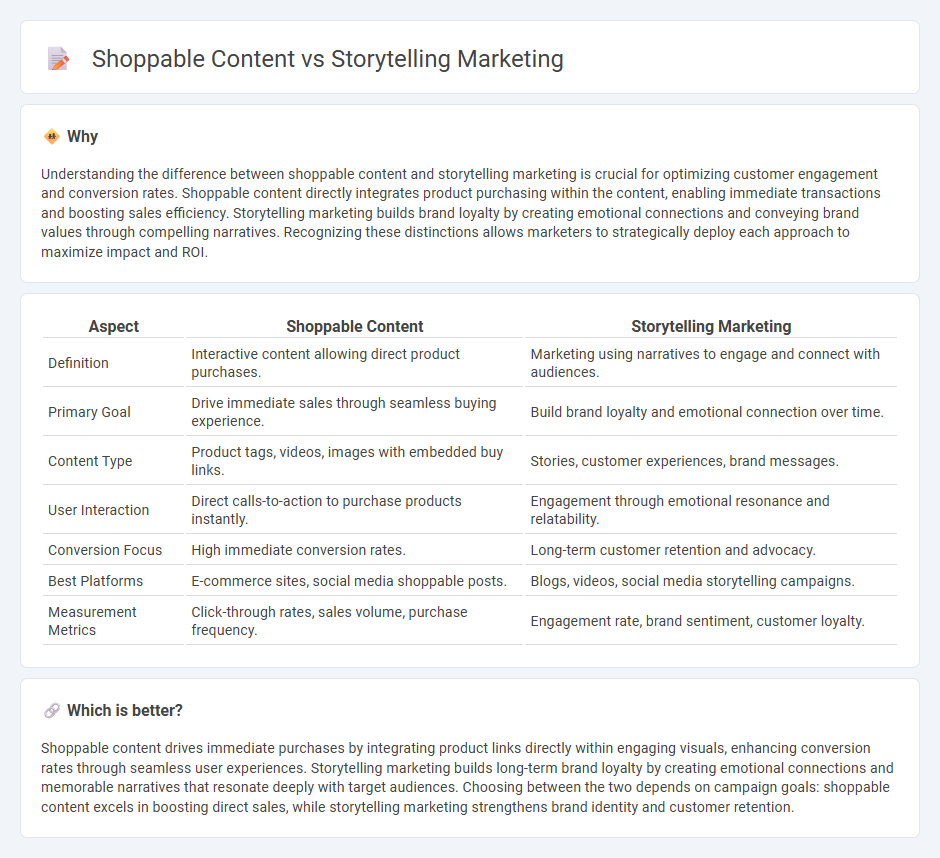
Shoppable content integrates direct purchasing options within engaging media, streamlining the path from discovery to transaction and boosting conversion rates. Storytelling marketing builds emotional connections by crafting narratives that resonate with audiences, enhancing brand loyalty and long-term engagement. Explore how combining shoppable content and storytelling can revolutionize your marketing strategy.
Why it is important
Understanding the difference between shoppable content and storytelling marketing is crucial for optimizing customer engagement and conversion rates. Shoppable content directly integrates product purchasing within the content, enabling immediate transactions and boosting sales efficiency. Storytelling marketing builds brand loyalty by creating emotional connections and conveying brand values through compelling narratives. Recognizing these distinctions allows marketers to strategically deploy each approach to maximize impact and ROI.
Comparison Table
| Aspect | Shoppable Content | Storytelling Marketing |
|---|---|---|
| Definition | Interactive content allowing direct product purchases. | Marketing using narratives to engage and connect with audiences. |
| Primary Goal | Drive immediate sales through seamless buying experience. | Build brand loyalty and emotional connection over time. |
| Content Type | Product tags, videos, images with embedded buy links. | Stories, customer experiences, brand messages. |
| User Interaction | Direct calls-to-action to purchase products instantly. | Engagement through emotional resonance and relatability. |
| Conversion Focus | High immediate conversion rates. | Long-term customer retention and advocacy. |
| Best Platforms | E-commerce sites, social media shoppable posts. | Blogs, videos, social media storytelling campaigns. |
| Measurement Metrics | Click-through rates, sales volume, purchase frequency. | Engagement rate, brand sentiment, customer loyalty. |
Which is better?
Shoppable content drives immediate purchases by integrating product links directly within engaging visuals, enhancing conversion rates through seamless user experiences. Storytelling marketing builds long-term brand loyalty by creating emotional connections and memorable narratives that resonate deeply with target audiences. Choosing between the two depends on campaign goals: shoppable content excels in boosting direct sales, while storytelling marketing strengthens brand identity and customer retention.
Connection
Shoppable content integrates seamless shopping experiences directly into engaging storytelling marketing, enhancing customer interaction and conversion rates. By embedding product links within compelling narratives, brands create immersive journeys that drive emotional connections and immediate purchases. This fusion optimizes digital marketing strategies by merging user engagement with streamlined e-commerce functionality.
Key Terms
Storytelling Marketing:
Storytelling marketing leverages narrative techniques to create emotional connections between brands and consumers, enhancing brand loyalty and engagement through compelling stories. This approach prioritizes authenticity and immersive experiences that resonate deeply with target audiences, driving higher retention and conversion rates. Explore more about how storytelling marketing transforms brand communication and boosts customer relationships.
Brand Narrative
Storytelling marketing focuses on crafting a compelling brand narrative that evokes emotions and builds deep connections with the audience, emphasizing authenticity and long-term loyalty. Shoppable content integrates e-commerce features directly into engaging media, streamlining the customer journey from story to purchase but often with less emphasis on narrative depth. Explore how balancing rich storytelling with seamless shopping experiences can elevate your brand strategy.
Emotional Engagement
Storytelling marketing leverages narrative techniques to create deep emotional connections with audiences, fostering brand loyalty and memorable experiences. Shoppable content integrates direct purchasing options within engaging media, streamlining consumer journeys while maintaining a focus on convenience and immediacy. Explore how these strategies uniquely enhance emotional engagement and drive consumer action.
Source and External Links
Storytelling Marketing: Definition, Elements & Examples - Storytelling marketing is the strategic use of narratives to emotionally connect with audiences, helping brands convey their message, highlight customer problems, and drive purchases by leveraging the brain's natural response to stories.
Storytelling in Content Marketing: The Ultimate Toolkit - Storytelling in marketing uses narrative techniques like customer success stories and consistent brand stories across materials to create emotional connections, build credibility, and engage customers effectively.
Story Marketing: Why It Matters and a Step-by-Step Guide - Story marketing builds consistent narratives centered on clients and company culture to emotionally engage audiences, enhance brand trust, and differentiate a business in a crowded market.
 dowidth.com
dowidth.com